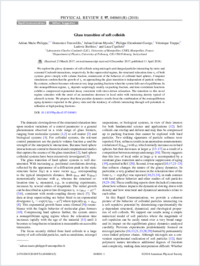Glass transition of soft colloids
- Philippe, Adrian-Marie Laboratoire Charles Coulomb (L2C), University of Montpellier, France
- Truzzolillo, Domenico Laboratoire Charles Coulomb (L2C), University of Montpellier, France
- Galvan-Myoshi, Julian Department of Physics, University of Fribourg, Switzerland
- Dieudonné-George, Philippe Laboratoire Charles Coulomb (L2C), University of Montpellier, France
- Trappe, Véronique Department of Physics, University of Fribourg, Switzerland
- Berthier, Ludovic Laboratoire Charles Coulomb (L2C), University of Montpellier, France
- Cipelletti, Luca Laboratoire Charles Coulomb (L2C), University of Montpellier, France
-
11.04.2018
Published in:
- Physical Review E. - 2018, vol. 97, no. 4, p. 040601
English
We explore the glassy dynamics of soft colloids using microgels and charged particles interacting by steric and screened Coulomb interactions, respectively. In the supercooled regime, the structural relaxation time τα of both systems grows steeply with volume fraction, reminiscent of the behavior of colloidal hard spheres. Computer simulations confirm that the growth of τα on approaching the glass transition is independent of particle softness. By contrast, softness becomes relevant at very large packing fractions when the system falls out of equilibrium. In this nonequilibrium regime, τα depends surprisingly weakly on packing fraction, and time correlation functions exhibit a compressed exponential decay consistent with stress-driven relaxation. The transition to this novel regime coincides with the onset of an anomalous decrease in local order with increasing density typical of ultrasoft systems. We propose that these peculiar dynamics results from the combination of the nonequilibrium aging dynamics expected in the glassy state and the tendency of colloids interacting through soft potentials to refluidize at high packing fractions.
- Faculty
- Faculté des sciences et de médecine
- Department
- Département de Physique
- Language
-
- English
- Classification
- Physics
- License
-
License undefined
- Identifiers
-
- RERO DOC 322580
- DOI 10.1103/PhysRevE.97.040601
- Persistent URL
- https://folia.unifr.ch/unifr/documents/307183
Statistics
Document views: 96
File downloads:
- pdf: 221
